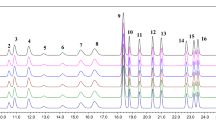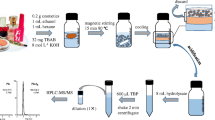Abstract
A simultaneous analytical method was developed and validated to quantify three lipophilic compounds; namely glabridin (an isoflavonoid isolated from crude licorice), (−)-α-bisabolol (a sesquiterpene alcohol obtained from plant extracts), and ascorbyl tetraisopalmitate (a fat-soluble molecule derived from vitamin C) in functional cosmetic cream using high-performance liquid chromatography (HPLC) coupled with photodiode array detection (PAD). Cosmetic cream samples were extracted with a mixture of acetonitrile and isopropyl alcohol (45:55, v/v) and the target compounds were separated on a C18 column with a gradient mobile phase consisting of deionized water, acetonitrile, and isopropyl alcohol. The detector wavelengths were 228, 202, and 221 nm, for glabridin, (−)-α-bisabolol, and ascorbyl tetraisopalmitate, respectively. The calibration curves showed good linearity with determination coefficients (R 2) ≥ 0.999. The mean recoveries were ranged between 89.8 and 103.9 % with relative standard deviations (RSDs) <5 %. The intra- and inter-day precision was <2 %. The limits of detection (LODs) were 0.03, 0.4, and 4.02 μg mL−1 for glabridin, (−)-α-bisabolol, and ascorbyl tetraisopalmitate, respectively. The method was successfully applied for monitoring 11 market samples, in which glabridin was quantified in the range of 17.5–25 mg 100 g−1, (−)-α-bisabolol in the range of 25.1–677 mg 100 g−1, and 140.6–291.5 mg 100 g−1 for ascorbyl tetraisopalmitate. The proposed analytical method is simple, sensitive, and versatile and can be used for the quantification of lipophilic compounds in cosmetics in a single chromatographic run.



Similar content being viewed by others
References
Korea Ministry of drug and food safety (2013) Cosmetic act, Seoul, Republic of Korea
Gao XH, Zhang L, Wei H, Chen HD (2008) Efficacy and safety of innovative cosmeceuticals. Clin Dermatol 26:367–374
Amer M, Maged M (2009) Cosmeceuticals versus pharmaceuticals. Clin Dermatol 27:428–430
Jeon JS, Kim HT, Kim MG, Oh MS, Hong SR, Yoon MH, Cho SM, Shin HC, Shim JH, Ramadan A, Abd El-Aty AM (2016) Simultaneous determination of water-soluble whitening ingredients and adenosine in different cosmetic formulations by high-performance liquid chromatography coupled with photodiode array detection. Int J Cosmet Sci 38:286–293
Chang ML, Chang CM (2003) Simultaneous HPLC determination of hydrophilic whitening agents in cosmetic products. J Pharm Biomed Anal 33:617–626
Jain P, Sonti S, Garruto J, Mehta R, Banga AK (2012) Formulation optimization, skin irritation, and efficacy characterization of a novel skin-lightening agent. J Cosmet Dermatol 11:101–110
Rendon M, Berneburg M, Arellano I, Picardo M (2006) Treatment of melasma. J Am Acad Dermatol 54:272–281
Huang SC, Lin CC, Huang MC, Wen KC (2004) Simultaneous determination of magnesium ascorbyl phosphate, ascorbyl glucoside, kojic acid, arbutin and hydroquinone in skin whitening cosmetics by HPLC. J Food Drug Anal 12:13–18
Jin W, Wang WY, Zhang YL, Yang YJ, Chu QC, Ye JN (2013) Determination of phenolic whitening agents in cosmetics by micellar electrokinetic capillary chromatography with amperometric detection. Chin Chem Lett 24:636–638
Jeon JS, Kim BH, Lee SH, Kwon HJ, Bae HJ, Kim SK, Park JA, Shim JH, Abd El-Aty AM, Shin HC (2015) Simultaneous determination of arbutin and its decomposed product hydroquinone in whitening creams using high-performance liquid chromatography with photodiode array detection: effect of temperature and pH on decomposition. Int J Cosmet Sci 37:567–573
Korea Ministry of drug and food safety (2013) Korean Functional Cosmetics Codex, Seoul, Republic of Korea
Jeon JS, Lee MJ, Yoon MH, Park JA, Yi H, Cho HJ, Shin HC (2014) Determination of arbutin, niacinamide, and adenosine in functional cosmetic products by high-performance liquid chromatography. Anal Lett 47:1650–1660
Simmler C, Pauli GF, Chen S-N (2013) Phytochemistry and biological properties of glabridin. Fitoterapia 90:160–184
Yokota T, Nishio H, Kubota Y, Mizoguchi M (1998) The inhibitory effect of glabridin from licorice extracts on melanogenesis and inflammation. Pigment Cell Res 11:355–361
Kamal YT, Singh M, Tamboli ET, Parveen R, Zaidi SM, Ahmad S (2012) Rapid RP-HPLC method for the quantification of glabridin in crude drug and in polyherbal formulation. J Chromatogr Sci 50:779–784
Rosenblat M, Belinky P, Vaya J, Levy R, Hayek T, Coleman R, Merchav S, Aviram M (1999) Macrophage enrichment with the isoflavan glabridin inhibits NADPH oxidase-induced cell-mediated oxidation of low density lipoprotein a possible role for protein kinase c. J Biol Chem 274:13790–13799
Waleczek KJ, Marques HMC, Hempel B, Schmidt PC (2003) Phase solubility studies of pure (−)-α-bisabolol and camomile essential oil with β-cyclodextrin. Eur J Pharm Biopharm 55:247–251
Murugan R, Mallavarapu GR (2013) α-Bisabolol, the main constituent of the essential oil of Pogostemon speciosus. Ind Crops Prod 49:237–239
Bhatia SP, McGinty D, Letizia CS, Api AM (2008) Fragrance material review on α-bisabolol. Food Chem Toxicol 46:72–76
Vila R, Santana AI, Pérez-Rosés R, Valderrama A, Castelli MV, Mendonca S, Zacchino S, Gupta MP, Cañigueral S (2010) Composition and biological activity of the essential oil from leaves of Plinia cerrocampanensis, a new source of α-bisabolol. Bioresour Technol 101:2510–2514
Kamatou GP, Viljoen A (2010) A review of the application and pharmacological properties of α-bisabolol and α-bisabolol-rich oils. J Am Oil Chem Soc 87:1–7
Kim S, Lee J, Jung E, Huh S, Park J-O, J-w Lee, Byun SY, Park D (2008) Mechanisms of depigmentation by α-bisabolol. J Dermatol Sci 52:219–222
Hakozaki T, Takiwaki H, Miyamoto K, Sato Y, Arase S (2006) Ultrasound enhanced skin-lightening effect of vitamin C and niacinamide. Skin Res Technol 12:105–113
Manela-Azulay M, Bagatin E (2009) Cosmeceuticals vitamins. Clin Dermatol 27:469–474
Almeida MM, Alves JMP, Patto DCS, Lima CRRC, Quenca-Guillen JS, Santoro MIRM, Kedor-Hackmann ERM (2009) Determination of tocopheryl acetate and ascorbyl tetraisopalmitate in cosmetic formulations by HPLC. Int J Cosmet Sci 31:445–450
Maia Campos PMBG, Gonçalves GMS, Gaspar LR (2008) In vitro antioxidant activity and in vivo efficacy of topical formulations containing vitamin C and its derivatives studied by non-invasive methods. Skin Res Technol 14:376–380
Gaspar LR, Campos PMBGM (2007) Photostability and efficacy studies of topical formulations containing UV-filters combination and vitamins A, C and E. Int J Pharm 343:181–189
Pedro AS, Detoni C, Ferreira D, Cabral-Albuquerque E, Sarmento B (2009) Validation of a high-performance liquid chromatography method for the determination of (−)-α-bisabolol from particulate systems. Biomed Chromatogr 23:966–972
Perbellini L, Gottardo R, Caprini A, Bortolotti F, Mariotto S, Tagliaro F (2004) Determination of alpha-bisabolol in human blood by micro-HPLC–ion trap MS and head space-GC–MS methods. J Chromatogr B 812:373–377
Scalia S, Giuffreda L, Pallado P (1999) Analytical and preparative supercritical fluid extraction of chamomile flowers and its comparison with conventional methods. J Pharm Biomed Anal 21:549–558
Weber B, Herrmann M, Hartmann B, Joppe H, Schmidt CO, Bertram H-J (2008) HPLC/MS and HPLC/NMR as hyphenated techniques for accelerated characterization of the main constituents in Chamomile (Chamomilla recutita [L.] Rauschert). Eur Food Res Technol 226:755–760
Aoki F, Nakagawa K, Tanaka A, Matsuzaki K, Arai N, Mae T (2005) Determination of glabridin in human plasma by solid-phase extraction and LC-MS/MS. J Chromatogr B Analyt Technol Biomed Life Sci 828:70–74
US Pharmacopeia (2009) General Chapters <1225> Validation of compendial methods. United States Pharmacopeal Convention, Inc., Rockville, Maryland, USA
Karageorgou E, Samanidou V (2014) Youden test application in robustness assays during method validation. J Chromatogr A 1353:131–139
Commission Decision 2002/657/EC implementing Council Directive 96/23/EC concerning the performance of analytical methods and the interpretation of results. Off J Eur Commun L221 8
Scortichini G, Annunziata L, Haouet MN, Benedetti F, Krusteva I, Galarini R (2005) ELISA qualitative screening of chloramphenicol in muscle, eggs, honey and milk: method validation according to the Commission Decision 2002/657/EC criteria. Anal Chim Acta 535:43–48
Furman WB, Dorsey JG, Snyder LR (1998) System suitability tests in regulatory liquid and gas chromatographic methods: adjustments versus modifications. Pharm Technol 22:58–65
US Food and Drug Administration (1994) Reviewer Guidance, validation of chromatographic methods. Centre for Drug Evaluation and Research, Washington
Acknowledgments
The authors gratefully acknowledge the financial support from the Gyeonggi Province Institute of Health and Environment (Suwon city, Republic of Korea).
Author information
Authors and Affiliations
Corresponding authors
Ethics declarations
Conflict of interest
The authors have declared no conflict of interest.
Rights and permissions
About this article
Cite this article
Jeon, JS., Kim, HT., Kim, MG. et al. Simultaneous Detection of Glabridin, (−)-α-Bisabolol, and Ascorbyl Tetraisopalmitate in Whitening Cosmetic Creams Using HPLC-PAD. Chromatographia 79, 851–860 (2016). https://doi.org/10.1007/s10337-016-3104-2
Received:
Revised:
Accepted:
Published:
Issue Date:
DOI: https://doi.org/10.1007/s10337-016-3104-2




